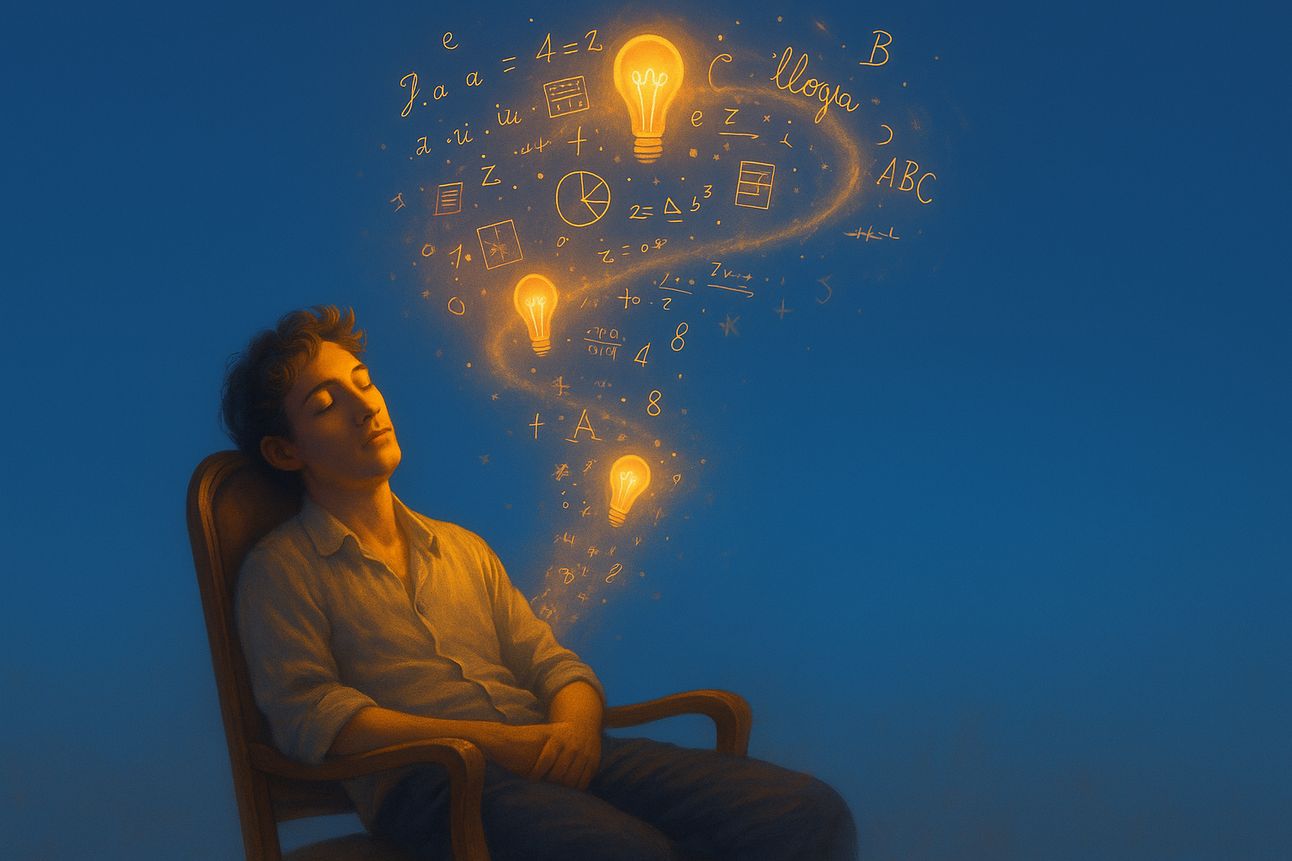- Kreatio
- Posts
- Catching the Genius of Your Wild Mind
Catching the Genius of Your Wild Mind
Don’t wait for great ideas, wander into them. (The Focus of Focus Series)

INSPIRING QUOTE
Creative Truth, Wrapped in a Joke
"I was trying to daydream, but my mind kept wandering."
This Steven Wright quote is intentionally paradoxical and nonsensical on the surface, but actually reveals something insightful about how our minds work. The joke is that daydreaming IS mind wandering.
🕺 The Paradox of Wandering Intentionally
But there's a deeper insight here: Wright is pointing out the contradiction in trying to control something that's inherently uncontrollable. When you "try" to daydream, you're imposing structure and intention on what should be a free-flowing, unstructured mental process. The moment you try to force your mind to wander in a particular direction, it naturally wants to go somewhere else entirely.
Kinda like when you’re trying to disconnect your bluetooth and it repeatedly reconnects— Why?! Ugh!
🧬 The DMN: Not Idle, But Wandering
Neuroscience has a name for what controls your wandering mind during a walk, a shower, or just before sleep: the Default Mode Network (DMN). This brain network kicks in when you’re not actively focused. The DMN is far from being idle, and is actually quietly powerful. It helps you connect distant ideas, reframe problems, and surface creative insights that your conscious mind might overlook.
The wandering mind isn’t out of focus, as the DMN description explains in a contradictory way: “not actively focused” + “far from being idle.” You may judge your wandering mind from the perceived notion that the only or best way to focus is like a laser. But the counterintuitive insight from above is that your wandering mind is actually focusing widely on disparate and subconscious things. So, let your DMN-led wandering mind do its magic!
In last week’s edition we shared our belief that shifting between laser-like focus and wandering focus is paramount to optimizing your creative and analytical thinking—
Wait, wait? How in the world do you shift and train your mind to control something that shouldn’t be controlled like a wandering mind? Wouldn’t that defeat the purpose of this week’s quote?
How often does your mind wander when you're not trying? |

This week Kreatio is sponsored by:
CREATIVITY SPOTLIGHT

Microdreams & Mental Magic
Thomas Edison was one of history’s most prolific inventors, credited with more than a thousand patents including those for the phonograph, the motion picture camera, and, of course, the light bulb. His work ethic was unparalleled, as for decades Edison worked twenty-hour days and sometimes even stretches of 60 to 72 consecutive hours. This isn’t the golden nugget to copy from his work process, though.
As there are only twenty-four hours in a day, Edison opined that sleep was “a heritage from our cave days.” But he was a prolific power napper. You can find many historical photographs of Edison napping, often in unusual places like his laboratory, on a cot, or even under a tree. But this isn’t the mental strategy I’d like to bring to your attention either.
From the yesteryear of pre-Instagram (speaking of which you can follow Kreatio on IG) there is no photographic evidence of this genius using his creative mental technique that involved sleep itself!
🧲 The Ritual: Clang Before the Idea
To harness his creative thinking potential, Edison devised a peculiar ritual…
He sat in a chair with a steel ball in each hand, arms resting over the edge. He placed a metal pan beneath each hand. Then he’d drift into one of his naps.
He’d let himself doze off, and just as sleep overtook him and his muscles relaxed, the balls would fall—CLANG!—jolting him awake.
That brief flicker of time, maybe up to 15 minutes between wakefulness and sleep? For Edison, that’s when the ideas came rushing in. Not polished, not fully formed, but raw and electric insights from the edges of his subconscious. He’d write them down immediately.
Some say this method inspired parts of the phonograph and even the lightbulb. Whether or not that’s provable, his method reflects a deeper truth: creativity often lives in transitions and intersections rather than in the grind.
🕰️ Dalí’s Dream Logic
Decades later and thousands of miles away, Salvador Dalí, arguably the most flamboyant dream-catcher in art history, would “slumber with a key.” He napped in a chair with a brass key dangling over a metal plate. As soon as he began to drift, the key would fall—CLINK!
Sound familiar? Sometimes history alliterates.
Dali claimed those moments were portal-like passages where logic and dreams of the waking world melted like memory across time or like clocks in the sun.
🌌 Science Catches Up: The Hypnagogic Zone
Modern science calls the liminal phase between waking and dreaming the hypnagogic state.
This state is a hybrid between wakefulness and sleep, and it is linked to vivid imagery, loose associations, and strange-but-useful-and-beautiful ideas.
Neither Edison nor Dali waited for ideas to arrive during their wakeful, laborious efforts. Instead, they devised rituals to invite ideas to wander to them.
So maybe next time you're stuck, don’t push harder. Sit back. Let go. And listen for what your half-asleep mind is trying to say before the balls drop.

BLINKS, THINKS & LINKS

Curiosity Candy
Can just the sounds of a shower get your mind wandering and creative?
Having a hard time getting yourself to nap at will? How to Fall Asleep in 2 Minutes (Military Technique)
Take a surreal virtual tour of Dalí’s mind-bending museum in Figueres, Spain, designed by Dalí himself.

ACTIONABLE PROMPTS

Taming the Wild Mind
Last week we explored honing your focus with Transcendental Meditation (TM). We’ll get back to honing your laser-like focus as we’ve got a lot more to say on that type of focus. And remember, both laser-like and wandering focus are very important, as they interact in a yin-and-yang way.
But this week it’s about wandering focus. We’ll start with three ways to stimulate your wandering focus, each one more challenging than the previous.
A quick neuroscience note on the first two prompts. These activate your brain’s Default Mode Network, the same neural network responsible for daydreams (e.g., the 3rd prompt below) and creative breakthroughs.
1️⃣ Beginner Level: Take a walk.
Take a minimum 10-15 minute walk.
Avoid all distractions as this isn’t a time to multitask. Don’t scroll through your phone.
Take notes if any ideas emerge. Use your phone to voice record or type notes; or use a notebook.
Who it worked for? Many across many disciplines, from Beethoven and Darwin to Dickens and Jobs.
2️⃣ Intermediate Level: Take more showers.
Prime Your Mind Before You Step In: Before you shower, think briefly about a problem or idea you're stuck on.
Then let the warm water and white noise do their thing—and stay open to whatever thoughts bubble up. Jot down anything interesting right after. Let this 5-10 minute shower stimulate your creative thinking.
Note any interesting ideas that emerged.
Bonus tip: Catch Ideas Before They Evaporate: Keep a waterproof notepad in the shower
Who it worked for? Aaron Sorkin (screenwriter The West Wing, The Social Network) has taken six to eight showers a day to overcome writer's block! Plus, Katy Perry and Lin-Manuel Miranda.
3️⃣ Advanced Level: The Microdream.
Version 1:
Sit in a chair holding a small object (e.g., key or metal ball) in your hand. Rest your arm over the side so the object dangles above a plate, tray, or other noisy surface.
Let yourself relax and start to doze off. As soon as you begin to fall asleep, the object will drop and wake you up.
Pay close attention to the images, thoughts, or ideas floating in your mind right before waking and take note of them immediately.
Version 2 with an alarm
No Props? No Problem: You can skip the key and plate.
Just lie down or sit comfortably, close your eyes, and set a timer for 10–15 minutes.
As you begin to drift toward sleep, stay gently aware of any images, phrases, or strange ideas that arise.
When the timer buzzes, write down whatever was floating in your mind.
Which creative method would you be most willing to try? |
Thanks for reading,
V.C. Hanna
Founder, Kreatio
This week Kreatio is also **sponsored** by:
Daily News for Curious Minds
Be the smartest person in the room by reading 1440! Dive into 1440, where 4 million Americans find their daily, fact-based news fix. We navigate through 100+ sources to deliver a comprehensive roundup from every corner of the internet – politics, global events, business, and culture, all in a quick, 5-minute newsletter. It's completely free and devoid of bias or political influence, ensuring you get the facts straight. Subscribe to 1440 today.

